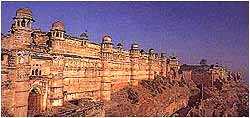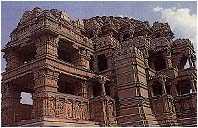|
|
|
|
|
|
|
Home » Indian
Cities » Cities of Central India » Gwalior
|
|
|
|
Back
» Gwalior
|
|
|
 The strategically important fort at Gwalior dominates the city and for centuries it controlled one of the major routes between north and south India. Its history goes back to 2000 years, with rock inscriptions from the 5th century still to be found. From the 12th century, the control of the fort and surrounding area passed through a succession of Muslim, Tomar, Rajput, Afghan, Mughal and finally Maratha rulers. During the 12th century Qutb-ud-din Aibak was the first ruler to hold it but eventually the Tomars took possession. It was under Man Singh, who came to power in 1486 that many of the great battlements and interior palaces were built. After a short period of control by Lodhis, the first Mughal emperor took over the fort, and described it as a “Pearl among the fortresses of Hind”. During the collapse of Mughal empire, the Scindia line of Marathas conquered the area in 1754. The British took control of it during the Maratha wars and held it for 30 years after capturing the Rani of Jhansi within its walls in 1858. The strategically important fort at Gwalior dominates the city and for centuries it controlled one of the major routes between north and south India. Its history goes back to 2000 years, with rock inscriptions from the 5th century still to be found. From the 12th century, the control of the fort and surrounding area passed through a succession of Muslim, Tomar, Rajput, Afghan, Mughal and finally Maratha rulers. During the 12th century Qutb-ud-din Aibak was the first ruler to hold it but eventually the Tomars took possession. It was under Man Singh, who came to power in 1486 that many of the great battlements and interior palaces were built. After a short period of control by Lodhis, the first Mughal emperor took over the fort, and described it as a “Pearl among the fortresses of Hind”. During the collapse of Mughal empire, the Scindia line of Marathas conquered the area in 1754. The British took control of it during the Maratha wars and held it for 30 years after capturing the Rani of Jhansi within its walls in 1858.
Sightseeing at Gwalior -
Gwalior Fort : On the way to the fort you pass through 21 Jain sculptures carved out of the rock. These sculptures date back to the 8th and 15th centuries. Enter the fort through Urwahi gate. The forts walls and buildings were constructed by different generations of rulers. The notable of them are the Suraj Kund, a tank built in 8th century AD, Teli ka Mandir, dedicated to Vishnu, this temple was build by Prathiharas (8th-11th centuries) is one of the oldest buildings; Two 11th century temples known as Sas Bahu ka Mandir also dedicated to Vishnu; the 16th century Gujri Mahal Palace and the Hindola Gate which houses a small archeological museum. The finest buildings in the fort is the Man Mandir Palace built by Raja Man Singh in the 15th century. Other buildings inside the fort are the interconnected Vikramaditya and Karan Palaces. Jai Vilas Palace and Museum The enormous Jai Vilas Palace built in the 19th century has a pair of world’s heaviest chandeliers in the Durbar Hall, and a crystal staircase. The dining table is fitted with electric train made of silver which carried brandy and cigars around the table after dinner. Thirty five rooms have been converted into a museum filled with family’s memorabilia.
Shivpuri : 114 kms from Gwalior is the old summer capital of Scindhias. Set in formal gardens, the Chhatris (tombs) are the main attraction here. With Mughal pavilions and sikhara spires these beautiful memorials to the Scindhia rulers are inlaid in Pietra dura style like the Taj Mahal.
Best Season to Visit - September to February.
 Reaching Gwalior : Reaching Gwalior :
Air : Regular flights connect Gwalior with Delhi, Bhopal, Indore and Mumbai.
Rail : Gwalior is on the Central Railway's main Delhi-Mumbai and Delhi-Chennai lines. Among other major trains, the Taj and Shatabdi Expresses connect Gwalior with Delhi and Agra.
Road : Gwalior is connected by regular bus services with Agra, Mathura, Jaipur, Delhi, Lucknow, Bhopal, Chanderi, Indore, Jhansi, Khajuraho, Rewa, Ujjain and Shivpuri.
STD /ISD Code for Gwalior :
If calling from within India dial
-------++0751(number)
If calling from outside India dial
-------++91751(number)
Shopping in Gwalior -
Perhaps the oldest bazaars in Madhya Pradesh are in Gwalior. In the lanes near the Chowk at Bara, shopkeepers claim a lineage that dates back several centuries. Chanderi sarees can be found here, along with choice fabrics with a traditional weave. The shops near Rajwara and Laskar, particularly at Patankar Bazaar, offer a mix of arts and crafts that are native to Gwalior. These include dolls, lacquerware, hand-woven carpets, wall hangings in the Gwalior style of painting, jewellery and crafts from other centres in Madhya Pradesh.
|
| |
|
|
|
|


